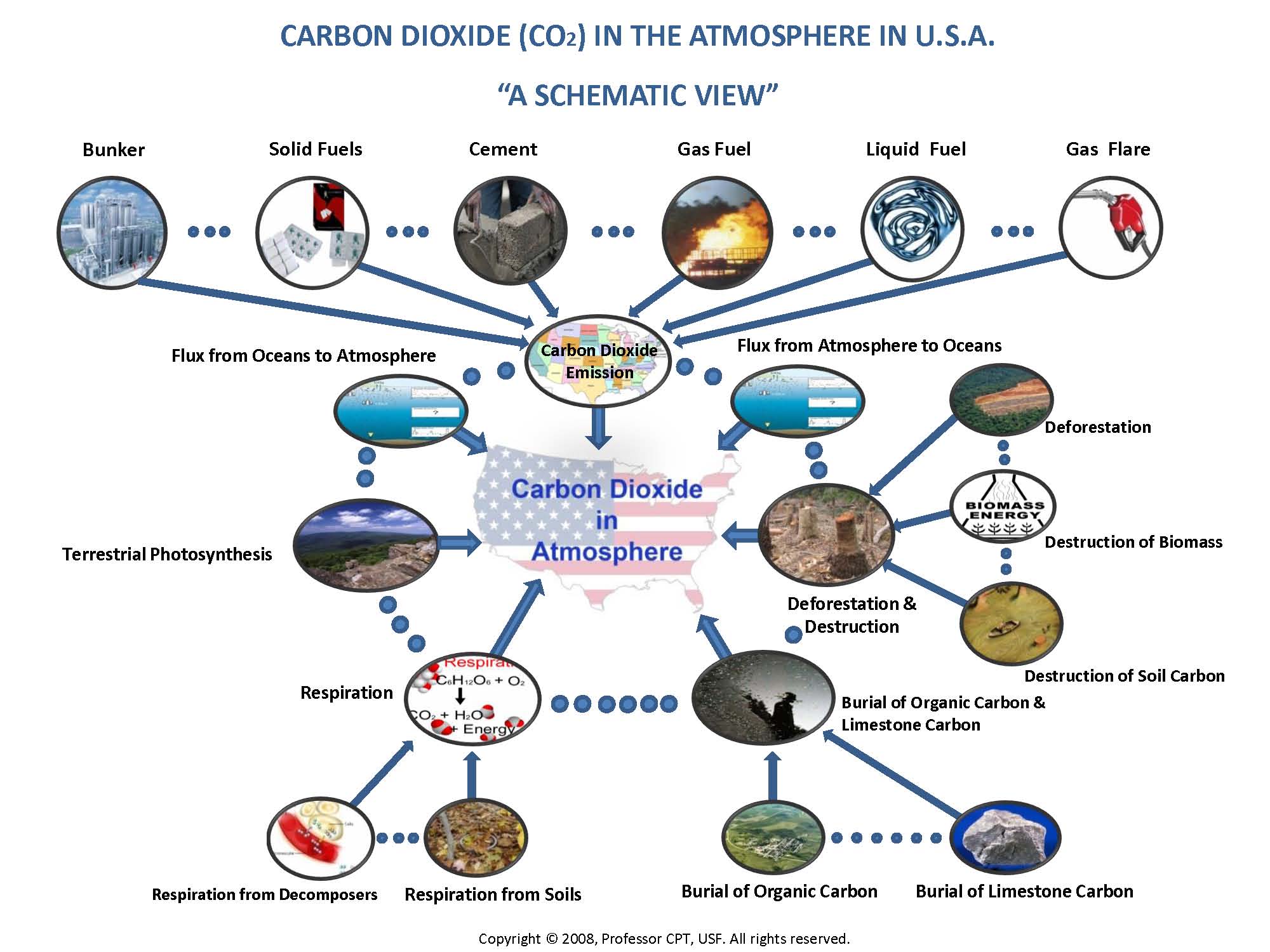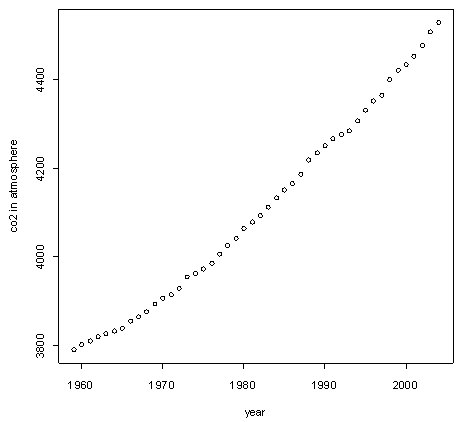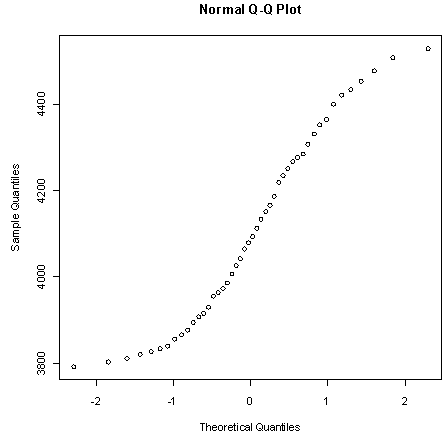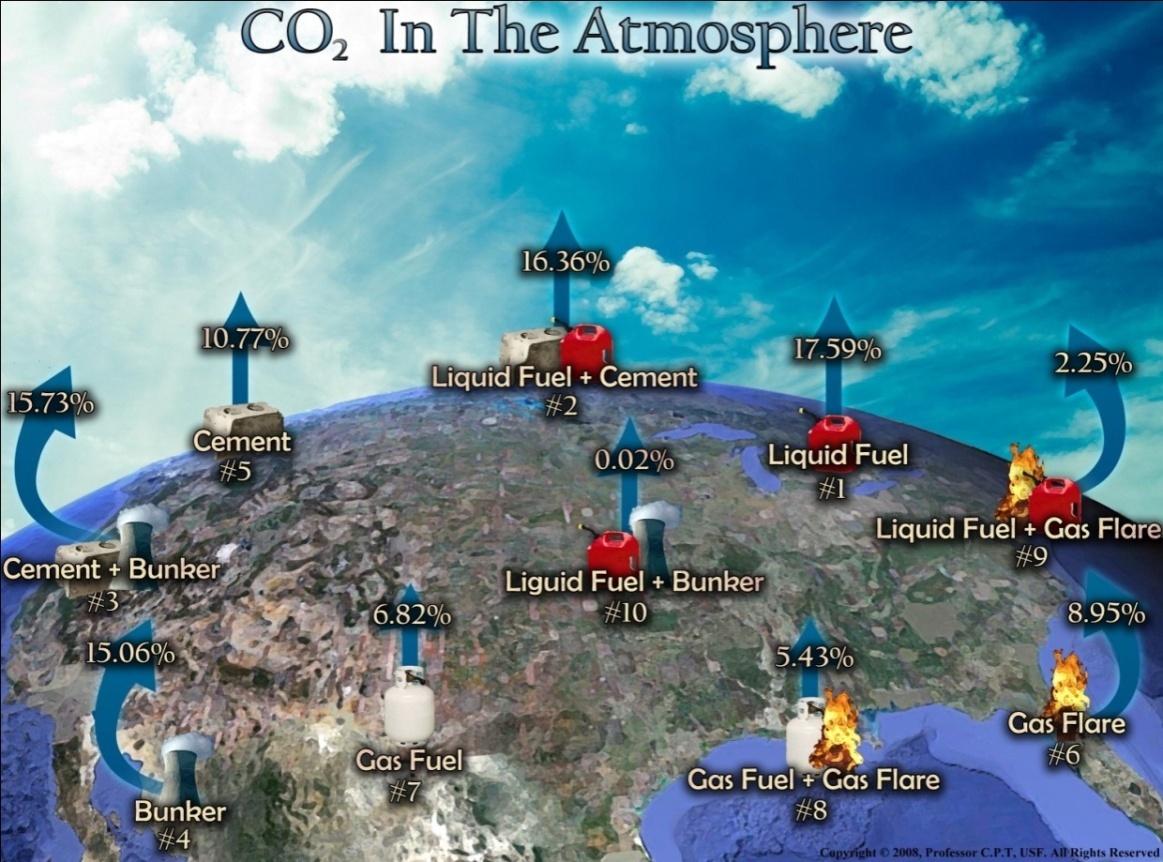-
Paper Information
- Next Paper
- Previous Paper
- Paper Submission
-
Journal Information
- About This Journal
- Editorial Board
- Current Issue
- Archive
- Author Guidelines
- Contact Us
Frontiers in Science
p-ISSN: 2166-6083 e-ISSN: 2166-6113
2013; 3(1): 6-13
doi:10.5923/j.fs.20130301.02
Attributable Variables with Interactions that Contribute to Carbon Dioxide in the Atmoshpere
1Department of Mathematics and Statistics, Radford UniversityRadford, Virginia, 24142, USA
2Department of Mathematics and Statistics, University of South FloridaTampa, FL, 33620, USA
Correspondence to: Chris P. Tsokos, Department of Mathematics and Statistics, University of South FloridaTampa, FL, 33620, USA.
| Email: |  |
Copyright © 2012 Scientific & Academic Publishing. All Rights Reserved.
GLOBAL WARMING is a function of two main contributable entities, atmospheric temperature and carbon dioxide, CO2. The object of the present study is to develop a statistical model to characterize the relation between CO2 in the atmosphere with six attributable variables which constitute CO2 emission. We will consider all sixattributable variables that have been identified by scientists and their corresponding response of the amount of carbon dioxide (CO2) in the atmosphere in the continental United States. The development of the statistical model that includes interactions, in addition to individual contributions to CO2 in the atmosphere, is included in the present study. The proposed model has been statistically evaluated and produces accurate predictions for a given set of the attributable variables. AMS Subject Classification: 62-07 and 62F07
Keywords: Short, Long Term Prediction of CO2 in Atmosphere, Statistical Modeling, Interactions, Attributable Variables
Cite this paper: Yong Xu, Chris P. Tsokos, Attributable Variables with Interactions that Contribute to Carbon Dioxide in the Atmoshpere, Frontiers in Science, Vol. 3 No. 1, 2013, pp. 6-13. doi: 10.5923/j.fs.20130301.02.
Article Outline
1. Introduction
- Wikipedia defines Global Warming as the increase in the average temperature of the Earth's near-surface air and oceans since the mid-20th century and its projectedstatistical model to predict CO2 in the atmosphere taking into consideration eight attributable variables to the subject matter. The eight attributable variables are namely, CO2 emission (E), deforestation and destruction of biomass and soil carbon (D), terrestrial plant respiration (R), respiration from soils and decomposers (S), the flux from oceans to atmosphere (O), terrestrial photosynthesis (P), the flux from atmosphere to oceans (I ), the burial of organic carbon and limestone carbon in sediments and soils (B).We need to mention here that some of the attributable variables are the function of several other variables within themselves. For example, CO2 emission, E, is a function of six attributable variables namely, Gas fuels (Ga), Solid fuels (So), Liquid fuels (Li), Gas Flares (Fl), Cement (Ce) and Bunker (Bu). Gas fuels include gas consisting primarily of methane. They includenatural gas and other gases that can provide energy through combustion. Solid fuels refer to various types of solid material that are used as fuel to produce energy and provide heating, usually released through combustion. Solid fuels include wood, charcoal, coal and others. Liquid fuels are those combustible or energy-generating molecules that can be harnessed to create mechanical energy, such as the gasoline we normally use. Gas flares is the vertical stack on oil wells or natural gas well completion activities. Cement refers to theCO2 generated through the production of cement. Bunker fuel is a type of crude oil also named heavy oil or furnace oil. It belongs to the heavy fractions or hard to distill fractions when crude oil is refined and often used for ships.The proposed model that we are developing takes into consideration individual contributions and interactions along with higher order contributions if applicable. In developing the statistical model, the response variable is the CO2 in the atmosphere and is given in unit parts per million (PPM). In the present analysis, we used real yearly data that has been collected from 1959 to 2004 for the continental United States. The air samples were collected at Mauna Loa Observatory, Hawaii. The CO2 emission data was obtained from Carbon Dioxide Information Analysis Center (CDIAC). The CDIAC is the primary climate-change data and information analysis center in the U.S. Department of Energy (DOE), located at Oak Ridge National Laboratory (ORNL) and includes the World Data Center for Atmospheric Trace Gases. All emission estimates are expressed in thousand metric tons of carbon (MT). Carbon emissions are calculated by the fuels consumed times the heat coefficient times the carbon coefficient times the combustion efficiency. The product of the fuels consumed times heat coefficient is in the unit of trillion Btu. The carbon coefficients are given by the Environmental Protection Agency (EPA) reports[1].It is the amount of carbon that is emitted per unit of heat realized from combustion. Petroleum data was obtained from DOE report, and are published in the Monthly Energy Review [2], [3], [4].
 | Figure 1. Carbon Dioxide in the Atmosphere in U.S.A |
2. Historical Review
- Hansen (1984) discuss the climate processes and climate sensitivity [5]. Lashof (1989) analyze the feedback processes that may influence future concentrations of atmospheric trace gases and climate change [6]. Thomas J. Goreau (1990) stated the eight attributable variables for CO2 in the atmosphere [7]. Retallack (2002) generally talk about the understanding climate change. Shih and Tsokos (2008) proposed a forecasting model for temperature and carbon dioxide for the United States and they suggest a weighted moving average procedure for forecasting [8], [9], [10]. Hachett and Tsokos (2009) discovered a new method for obtaining a more effective estimate of atmospheric temperature in the united states [11].Tsokos and Xu (2009) have proposed differential equations for individual attributable variables for CO2 emission and cumulatively [12]. The parametric analysis for CO2 has been studied extensively by Wooten and Tsokos (2010) [13]. They have found that the CO2 data follows the three parameter Weibull probability distribution contrary to the fact that some scientists believed that CO2 in the atmosphere follows Gaussian probability distribution. Xu and Tsokos (2011) have proposed an overall model to modeling the CO2 in the atmosphere and all possible attributable variables [14]. Several other recent researches can be found in [15], [16] and [17]. In this study we will follow up the research in [14] to construct an improved overall model for those significant attributable variables and the cumulatively CO2 in the atmosphere. We will use the most updated data to construct this model and we will show the improvement in the result.The illustration of Carbon dioxide circulation process in the atmosphere that was developed by scientists at the Oak Ridge National laboratory is given by Figure 2, below. (from ICPP’s report)
 | Figure 2. CO2 Circulations in Atmosphere |
3. Development of Nonlinear Statistical Model
- We proceed to develop a statistical model taking into consideration the eight attributable variables as presented previously. The form of the statistical model is given by CO2 in the atmosphere as a function of temperature. Thus, the statistical form of the model with all possible interactions will be
 | (3.1) |
 and
and  are the coefficients and A are the first order term of the attributable variables and B are the possible interactions and higher order terms. The object is to develop the most representative estimate of the above model based on available data. In the present study we will focus on using atmospheric CO2 as response and only six attributable variables as our independent variables. For the overall model that considers all possible attributable variables, please check the Xu and Tsokos paper 2010. The data comes from Oak Ridge National Lab: Division of U.S. Department of Energy. The plot of CO2 in the atmosphere is shown in Figure 3, below. The air samples collected at Mauna Loa Observatory, Hawaii and the data unit is in ppmv.One of the underlying assumptions to construct the above model 3.1 is that the response variable should follow Gaussian distribution. We know the CO2 in the atmosphere are not follow Gaussian distribution which can be clearly seen from the QQ plot shown by Figure 4, below. We will utilize Box-Cox transformation to the CO2atmosphere data to filter the data to be normally distributed. After we proceed with the Box-Cox transformation, the results are shown in Table 1.
are the coefficients and A are the first order term of the attributable variables and B are the possible interactions and higher order terms. The object is to develop the most representative estimate of the above model based on available data. In the present study we will focus on using atmospheric CO2 as response and only six attributable variables as our independent variables. For the overall model that considers all possible attributable variables, please check the Xu and Tsokos paper 2010. The data comes from Oak Ridge National Lab: Division of U.S. Department of Energy. The plot of CO2 in the atmosphere is shown in Figure 3, below. The air samples collected at Mauna Loa Observatory, Hawaii and the data unit is in ppmv.One of the underlying assumptions to construct the above model 3.1 is that the response variable should follow Gaussian distribution. We know the CO2 in the atmosphere are not follow Gaussian distribution which can be clearly seen from the QQ plot shown by Figure 4, below. We will utilize Box-Cox transformation to the CO2atmosphere data to filter the data to be normally distributed. After we proceed with the Box-Cox transformation, the results are shown in Table 1.
|
 | Figure 3. Yearly CO2 in Atmosphere Data at Mauna Loa |
 | Figure 4. QQ Plot for Testing Normality |
 | (3.2) |
 | (3.3) |
 | Figure 5. CO2 in the AtmosphereAttributable Variable Diagram |
 The prediction of residual error sum of squares (PRESS) statistics will evaluate how good the estimation will be if each time we remove one data point and PRESS is defined
The prediction of residual error sum of squares (PRESS) statistics will evaluate how good the estimation will be if each time we remove one data point and PRESS is defined For our final model the R squared is 0.9963 and R squared adjusted is 0.9953. Both R squared and R squared adjusted are very high (more than 90%) and these two are very close to each other. This shows our model’s R squared increase in not due to the increase of the parameters estimates but the good quality of the proposed model to predict CO2 in the atmosphere given values of the identified attributable variables[2]. Secondly, the PRESS statistics results support the fact that the proposed model is of high quality. We will list the best three models’ PRESS statistic out of total 28 and the result is in Table 2, below. From the table it is clear that the best model is number 28, which is our final model.
For our final model the R squared is 0.9963 and R squared adjusted is 0.9953. Both R squared and R squared adjusted are very high (more than 90%) and these two are very close to each other. This shows our model’s R squared increase in not due to the increase of the parameters estimates but the good quality of the proposed model to predict CO2 in the atmosphere given values of the identified attributable variables[2]. Secondly, the PRESS statistics results support the fact that the proposed model is of high quality. We will list the best three models’ PRESS statistic out of total 28 and the result is in Table 2, below. From the table it is clear that the best model is number 28, which is our final model.
|
 | Figure 6. CO2 in the AtmosphereAttributable VariableContribution Diagram |
|
|
4. Validation of the Proposed Model
- We will utilize two methods to do the model validation. The first method is to use the proposed model to calculate the predicted value for each individual data and then calculate the residuals. The residual is defined as the original value minus the predicted value. Table 5 shows the last ten residuals out of the total one hundred fifty-five residuals. The mean of the residuals is -.0286, variance of the residuals is 1.588, standard deviation is 1.26 and standard error of the residuals is .1012.
|
|
5. Usefulness of the Proposed Model
- We can conclude from our extensive statistical analysis that there are only five significant attributable variables to the CO2 in the atmosphere namely, Gas fuels, Gas flares, Bunker, Liquid and Cement. Furthermore, we also tested all possible 2nd order interactions of allattributable variables and we found only five interactions that significantly contribute to CO2 in the atmosphere, namely, Liquid with Cement, Cement with Bunker, GasFuels with Gas Flares, Liquid with Gas Flares and Gas Flares with Bunker. Thus, one may obtain a good estimate of the CO2 in the atmosphere by knowing the measurement of Cement and those five interactions. One can utilize the above model equation 3.2 to perform surface response analysis to identify the values of the contributable variables that will minimize the CO2 in the atmosphere.
6. Conclusions & Discussion
- In the present study, we have performed parametric analysis for CO2 in the atmosphere. The initial measurement of CO2 in the atmosphere was collected at Mauna Loa Observatory, Hawaii (C.D. Keeling, T.P. Whorf, 2005). Those data do not follow normal probability distribution. Thus, we transform the response of the data by using Box-Cox transformation that resulted in make the CO2 being normal. The developed statistical was validated and is extremely accurate. Using this model we have identified the important and unique information that only five attributable variables, namely liquid, bunker, cement, gas flares, and gas fuels significantly contribute to the amount of CO2 in the atmosphere along with five interactions, namely, liquid-cement, cement-bunker, gas fuels-gas flares, liquid-gas flares, and gas flares-bunker. Scientists working in the subject area list at least twenty attributable variables and no interactions that contribute to CO2 in the atmosphere. The high accuracy of our predictive model is reflected by the values of R square and R square adjusted and the PRESS statistics. Furthermore, the statistical model was cross validated by hiding some actual CO2 data and proceed to estimate the CO2 from the model, the mean residuals of the cross validation is extremely small, that further reflects the accuracy of our results. We proceeded to use the statistical model to rank the attributable variable and interactions with respect to the percent amount of CO2 they contribute in the atmosphere. Liquid fuels is number one with the interactions of gas flares and bunker contribute the minimum (number 10) significant amount of CO2 in the atmosphere. The developed statistical model can be used; I. To estimate the CO2 in the atmosphere. II. Can be used for research funding allocations based on the ranking of the attributable variables. III. Use the model and its findings to establish environmental policies to address the issues of CO2 in the atmosphere. IV. Develop economic models based on the present findings to assist in implementing the legal policies. V. Use the developed statistical model to identify violation of the established legal policies.
ACKNOWLEDGEMENTS
- The authors wish to acknowledge the assistance and suggestions of T.J. Blasing from Oak Ridge National Laboratory during the progress of the present study.
References
| [1] | Marland, G., R. Andres, T.J. Blasing, T.A. Boden, C.T. Broniak, J.S. Gregg, L.M. Losey, and K. Treanton, 2007. Energy, Industry, and Waste Management Activities: An Introduction to CO2 Emissions from Fossil Fuels. pp 57-64 IN: First State of the Carbon Cycle Report (SOCCR): The North American Carbon Project and Implications for the Global Carbon Cycle., United States Climate Change Science Program Synthesis and Assessment Product 2.2, National Oceanic and Atmospheric Administration, National Climatic Data Center, Asheville, NC, USA. 242 pp. |
| [2] | Blasing, T.J., C.T. Broniak and G. Marland, 2005. State-by state carbon dioxide emissions from fossil fuels use in the United States 1960-2000. Mitigation and Adaptation Strategies for Global Change 10, 659-674Blasing, T.J., C.T. Broniak and G. Marland, 2005. The annual cycle of fossil-fuels carbon dioxide emissions in the United States.Tellus, 57B, 107-115. |
| [3] | Blasing, T.J., K. Hand. 2007. Monthly carbon emissions from natural-gas flaring and cement manufacture in the United States. Tellus59B, 15-21. |
| [4] | Blasing, T.J., C.T. Broniak and G. Marland, 2005. The annual cycle of fossil-fuels carbon dioxide emissions in the United States. Tellus, 57B, 107-115. |
| [5] | Hansen, J., Takahashi. T, 1984. Climate processes and Climate Sensitivity. Geophysical Monograph 39. American Geophysical Union, Washington DC. |
| [6] | Lashof, D., 1989. The dynamic greenhouse: feedback processes that may influence future concentrations of atmospheric trace gases and climatic change. Climatic Change 14, 213-242 |
| [7] | Goreau, J. T. , 1990. Balancing Atmospheric Carbon Dioxid. Ambio, Vol. 19, No. 5 (Aug., 1990), pp. 230-236 |
| [8] | Shih, S. H.,Tsokos, C. P., 2007. A Weighted Moving Average Procedure for Forecasting, Journal of Modern Applied Statistical Methods, JMAS, vol.6, No.2 |
| [9] | Shih, S. H.,Tsokos, C. P., 2008. A Temperature Forecasting Model for the Continental United States, J. Neural; Paralles& Scientific Computing, 16, pp59-72. |
| [10] | Shih, S. H.,Tsokos, C. P., 2008. Prediction Model for Carbon Dioxide Emission in the Atmosphere, J. Neural; Paralles& Scientific Computing, vol 16, No.1, pp165-178. |
| [11] | Hachett, K., Tsokos, 2009. C. P. A New Method for Obtaining a More Effective Estimate of Atmospheric Temperature in the Continental United States, J. Real Analysis/ Applied Math. |
| [12] | Tsokos, C. P, Xu, Y., 2009. Modeling Carbon Dioxide Emission with a System of Differential Equations, J. Real analysis/ applied Math, JRAAM, Vol. 71, Issue 12, pages e1182-e1197. |
| [13] | Wooten, R., Tsokos, C. P.,2010. Parametric Analysis of Carbon Dioxide in the Atmosphere. Journal of Applied Sciences 10 (6), pp. 440-450. |
| [14] | Xu, Y.,Tsokos, C. P., 2011.Statistical models and analysis of Carbon Dioxide in the Atmosphere, Problems Of Nonlinear Analysis In Engineering Systems, Issue 2(36). |
| [15] | Tsokos, C. P. 2008, Statistical Modeling of Global Warming. The 5th International Conference on Dynamic Systems and Applications, ICDSS5, vol 5, pp 461-466 |
| [16] | Tsokos, C. P., 2010. Mathematical and Statistical Modeling of Global Warming. International lexicon of Statistical Sciences, pp 1-10 |
| [17] | Tsokos, C. P., 2009. Global Warming: Myth and Reality, Hellenic News of America, Vol. 23, No.3, pp 1-3. |
| [18] | Allen D. M., 1971. The Prediction Sum of Squares as a Criterion for Selecting Predictor Variables. Technical Report Number 23 (1971), Department of Statistics, University of Kentucky. |
| [19] | Allen D. M., 1974. The relationship between variable selection and data augmentation and a method for prediction.Technometrics (1974), 16:25-127. |
 Abstract
Abstract Reference
Reference Full-Text PDF
Full-Text PDF Full-text HTML
Full-text HTML